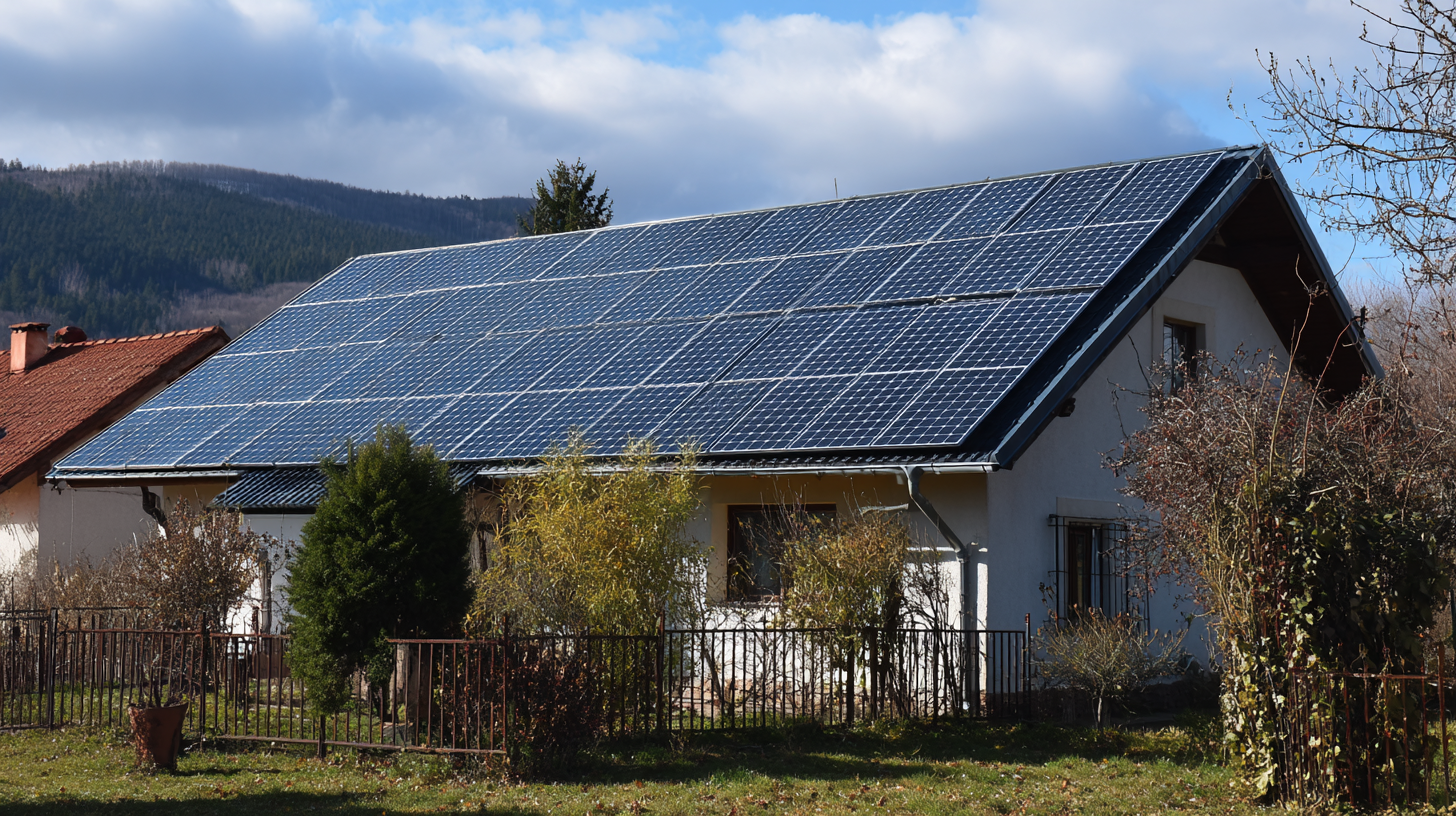Unlocking Savings: How Solar Electricity for Home Can Reduce Your Energy Bills by Up to 70%
With energy costs continuing to rise, homeowners are increasingly turning to innovative solutions to manage their bills. One such solution is solar electricity for home, a technology that reports potential savings of up to 70% on electricity expenses. According to a recent report by the National Renewable Energy Laboratory, the average U.S. household can offset nearly 90% of its annual energy bill by utilizing solar power, making it a pivotal investment for both financial and environmental sustainability. The shift towards solar energy not only provides significant savings but also contributes to a reduction in carbon emissions, aligning with global targets for clean energy.

As the renewable energy sector evolves, these benefits only become more pronounced, highlighting the importance of adopting solar electricity as a practical and cost-effective solution for homeowners looking to unlock substantial savings.
Understanding Solar Electricity and Its Benefits for Homeowners
 Solar electricity is becoming increasingly viable for homeowners looking to cut their energy bills significantly. According to a report from the U.S. Department of Energy, residential solar systems can reduce electricity costs by as much as 70%. This is primarily due to the ability to harness sunlight, converting it into usable energy, reducing reliance on grid electricity, and protecting homeowners from future rate hikes. Furthermore, the average payback period for solar panels has fallen to around five to seven years, making investments in solar not only economically smart but also sustainable.
Solar electricity is becoming increasingly viable for homeowners looking to cut their energy bills significantly. According to a report from the U.S. Department of Energy, residential solar systems can reduce electricity costs by as much as 70%. This is primarily due to the ability to harness sunlight, converting it into usable energy, reducing reliance on grid electricity, and protecting homeowners from future rate hikes. Furthermore, the average payback period for solar panels has fallen to around five to seven years, making investments in solar not only economically smart but also sustainable.
Homeowners can also benefit from various incentives and rebates designed to encourage solar adoption. The Solar Investment Tax Credit (ITC) allows homeowners to deduct a significant percentage of their solar system costs from federal taxes, making the initial investment more manageable. A report by the National Renewable Energy Laboratory highlights that as of 2022, over 3 million homes in the U.S. have adopted solar technology, showcasing the growing awareness and acceptance of solar electricity. These benefits indicate that solar energy is not just a trend but a substantial opportunity for homeowners to create lasting financial savings while contributing to a cleaner environment.
Evaluating Your Home's Suitability for Solar Panel Installation
Evaluating the suitability of your home for solar panel installation is a crucial first step in unlocking significant savings on energy bills. According to a report by the Solar Energy Industries Association (SEIA), homeowners can reduce their electricity costs by up to 70% by switching to solar energy. However, not all homes are equally suited for solar panels. Key factors include roof orientation, shading, and structural integrity. A south-facing roof that receives ample sunlight throughout the day is ideal for maximizing solar generation.
To determine if your home is suitable, first assess the amount of sunlight your roof receives. Trees, buildings, or other obstacles may cause shading that can significantly reduce the efficiency of solar panels. Additionally, consider the age and condition of your roof; an older roof may need repairs or replacement before solar installation. A study by the National Renewable Energy Laboratory (NREL) indicates that homes with optimal solar conditions can generate 20% to 30% more electricity, leading to greater savings over time.
Tips:
- Use online solar calculators to estimate potential energy savings based on your location and roof characteristics.
- Consult with a professional solar installer who can provide a site assessment to identify the best solar solutions tailored to your home’s needs.
- Explore local incentives or rebates that can further enhance the financial viability of solar installation.
Calculating Potential Savings: How to Estimate Reduced Energy Bills
To estimate potential savings from installing solar electricity in your home, it’s crucial to analyze your current energy consumption and costs. Start by reviewing your electricity bills for the past year to determine your average monthly usage in kilowatt-hours (kWh). This data provides a baseline to understand how much energy you rely on from traditional sources. Once you have this figure, you can estimate the capacity of the solar system needed to meet a significant portion of your energy requirements.
Next, consider the production capacity of solar panels. On average, a typical solar panel can produce between 250 to 400 watts, depending on the model and environmental factors. By evaluating local sunlight conditions and calculating the number of panels required, you can forecast how much of your energy needs can be offset by solar generation. Additionally, take into account potential tax credits, incentives, and financing options that can further enhance your savings. By combining these elements, you can effectively estimate your reduced energy bills and grasp the financial benefits of switching to solar energy.
Unlocking Savings: Potential Energy Bill Reductions with Solar Electricity
This chart shows the estimated percentage reduction in energy bills based on the size of the solar panel system installed. Utilizing solar electricity can lead to significant savings over time.
Choosing the Right Solar Panel System: A Homeowner’s Guide
Choosing the right solar panel system can significantly impact your energy savings, with some homeowners reporting reductions in energy bills by up to 70%. When selecting a solar power system, it’s essential to evaluate the various technologies available in the market. High-efficiency solar panels, such as monocrystalline panels, typically offer better performance in limited spaces, making them a worthy investment. According to recent data, a solar panel system can pay itself off in 5 to 7 years, depending on local energy prices and installation costs.

Tips for Choosing the Right Solar Panel System:
1. Assess your energy needs: Calculate your average monthly energy consumption to understand the size of the solar system required to meet your needs.
2. Research local incentives: Look into government incentives and rebates for solar panel installation in your area, which can significantly lower your overall costs.
3. Select certified products: Ensure that any solar panels you consider carry necessary certifications to minimize risks such as fire hazards and to ensure long-term reliability.
Recent developments in regulations have also impacted homeowners' choices. For instance, new rules in Australia allow energy companies to charge fees for electricity fed back into the grid, making it crucial for homeowners to understand their local policies when investing in solar technology.
Navigating Incentives and Financing Options for Solar Energy Investment
Investing in solar electricity for your home presents a significant opportunity to reduce energy bills, especially as incentives and financing options continue to evolve. With the recent shifts in policy and energy markets, particularly amid potential changes under varying political climates, homeowners must navigate a landscape that can be both promising and complex. Understanding available incentives, such as tax credits and state programs, is essential for maximizing the return on your investment in solar energy.
The current turmoil in the solar industry, influenced by tariffs and market fluctuations, underscores the importance of choosing the right installer. As some prominent solar companies face instability, homeowners should conduct thorough research to identify trustworthy providers who can offer competitive financing options. Additionally, as savings from solar can reach up to 70%, it's crucial to stay informed about changes in government policies that may affect incentives, ensuring that your investment is both economically sound and aligned with the latest energy trends.
Unlocking Savings: How Solar Electricity for Home Can Reduce Your Energy Bills by Up to 70% - Navigating Incentives and Financing Options for Solar Energy Investment
| Incentive/Financing Option | Description | Estimated Savings (%) | Additional Benefits |
|---|---|---|---|
| Federal Tax Credit | A federal incentive that allows homeowners to deduct a percentage of solar installation costs from their federal taxes. | 26% | Reduces overall installation costs; encourages renewable energy use. |
| State Rebate Programs | Financial rebates provided by state governments upon the installation of solar systems. | 10-30% | Immediate reduction in upfront costs; varies by state. |
| Power Purchase Agreements (PPAs) | An agreement with a solar provider to buy the generated solar electricity at a set rate. | 15-30% | No upfront costs; pay only for what you use. |
| Solar Loans | Loans specifically designed to finance the purchase and installation of solar systems. | Up to 70% in energy savings over time | Ownership of the system; potential for lower energy bills immediately. |
| Net Metering | A billing mechanism that credits solar energy system owners for the electricity they add to the grid. | 20-50% | Helps to offset energy costs; increases return on investment. |
Related Posts
-

What is Solar System Installation? Unlocking the Key Components and Benefits for Your Home
-

Ultimate Guide to Choosing the Best Solar Energy Panels for Your Home
-

10 Essential Tips for Sourcing Solar Panels Effectively in 2024
-

How to Seamlessly Integrate Solar Energy Installation into Your Home
-

Why Solar System Installation is a Smart Move for Your Home
-

How to Source Quality Suppliers for Best Solar System Installation with a Comprehensive Checklist